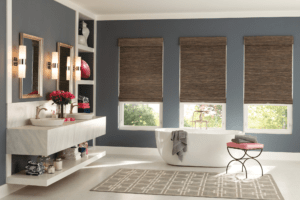How Lighting Affects Mood

It’s called “mood lighting” for a reason. We are creatures of the sun, and the light is calling a lot more shots than we might think. Our circadian rhythm, the 24-hour cycle that organizes our daily biological routines, is dependent on light to set its clock. When you have jet lag, or when you change shifts at work, you’re disrupting your circadian rhythm. Most people know that changing to the graveyard shift is difficult, and getting over jet lag is awful, but less dramatic disruptions are often the root cause of a lot of frustration. Bright, cool lights in your bedroom or dim yellow lights in your kitchen could be making your family irritable, ruining their sleep, or contributing to poor school performance.
Knowing how lighting affects mood can help you bring balance to your home. Simple, smart changes to how you light each room in your home can dramatically improve your daily mood, sleep, and even cognition.
What Kinds of Lights Go Where?
Choosing the best lighting for your rooms starts with choosing the right kind of light source. How do you know if LED ceiling lights are best for a living room? How do you know what color light to get? While incandescent or fluorescent lights may be more familiar, the best options by far are new LED technologies. LED lights are much more precise and available in every brightness, temperature, and color you could need. LED lights make it easy to find the correct kind of light for a room—each is labeled according to the kind of light you want.
Light temperatures of 3000-3500k are neutral, or even a cooler color and are best for morning or day activities where you need to be awake and alert (think kitchen or a home office), while 2200-2700k are relaxing, warm light colors that are perfect mood lighting for a bedroom or den. Lumen counts listed on the bulbs will tell you if you have enough light for your intended activities. An LED light bulb with only 200 lumens might be perfect for your bedside lamp, but you’ll want much more light where you’ll be shaving or putting on makeup.
Relaxing or Invigorating
The circadian rhythm is greatly influenced by the light you’re exposed to. Each room’s lighting should be determined by assessing the function of the room. Your kitchen lighting shouldn’t be the same as the lighting in your bedroom or bath. Bright, neutral, or blue-toned light mimics daylight and helps wake us up and stay concentrated. Soft, warm white light is best for bedrooms or dining rooms where the main purpose is to relax or spend quiet time. We know that reading your phone before bed can make it much more difficult to settle into sleep, and the same concepts apply to light in your room. Reading a book by the soft, warm light coming from dimmable bedside sconces helps your brain know that work is over and it’s almost time to sleep.
Multi-tasking Lighting for Multi-functional Spaces
Knowing how your family uses (or would like to use) the spaces you’re updating is crucial to making the choices that aid your natural cycle. In the modern home, most rooms are multi-functional; your office may be a guest room in a pinch, and the kids might do their homework in the formal dining room. Addressing these different needs is as simple as layering the light sources within a space.
In a bathroom, you may want bright light for waking up and getting ready for the day, but more gentle light for relaxing evening baths. Choose an LED vanity with bright neutral light (3000k light temperature and a lumen output of more than 1500) and a dimmable overhead flush mount with a warmer feel (2200K light temperature and maybe 1000 or fewer lumens). In another example, dimmable LED ceiling lights for the living room paired with some simple table lamps allow the space to be functional as both a study hall and a recreational space.
Overcoming Limitations
Sunlight is the best kind of light for supporting your natural rhythm and providing you with much-needed vitamin D, but not every room in the home can have an abundance of windows and good exposure throughout the day. LED lights are a great solution to many functional and architectural limitations. Having a dimmable, bright LED light source in say, a finished basement, can make the space infinitely more usable. Using warm, dimmable LED bulbs in a grand chandelier is not only effective lighting for a welcoming entrance space but is especially useful for homes with high ceilings.
Using lighting in your home to support your natural circadian rhythm can be extremely effective in improving your moods, your sleep, and your performance at work or school.
Choosing the correct lighting for the correct space can help chase away the winter blues and assist in getting the kids settled down before bed. By using all the tools available and all that we know about our sleep cycle, it’s easy to tailor the light in your home to be a source of positive energy and assist your biological and emotional health.
Sheva Knopfler
With a background in design and lighting, Sheva, along with her husband David, launched Lights.com, an alternative shopping experience featuring modern, affordable, direct-to-consumer lighting.
Colored Lighting
In addition to regulating circadian rhythms, sleep cycles, and health, you can also incorporate colored lighting to enhance certain moods. There are common associations between certain colors and emotions—for example, blue is perceived by many people as a calming or melancholy color. Artificial lighting can be used to evoke emotions in certain spaces in your home. Some common colors that can be used include:
- Yellow – can bring more intense feelings of cheerfulness to a room
- Green – depending on the shade, is known for creating an earthy environment or an atmosphere that promotes wealth
- Purple – can feel luxurious (but can also be interpreted as melancholic)
- Red – lends to a feeling of passion, anger, or intensity
Various temperatures and hues of colored mood lighting can serve different purposes in different spaces in your home. It all depends on what your goals for the spaces are and the moods you’d like to encourage. And you don’t have to commit to one—consider trying an adjustable smart light to experiment with different colors and see how they make you feel.
Match Your Lighting With New Window Treatments
Do you have a plan to create the right moods for different spaces in your home using lighting with various temperatures, hues, or colors? Consider new window treatments to complement your lighting and enhance the aesthetic of your space. Galaxy Draperies can help complete your interior design with gorgeous, high-quality window treatments that match your needs. Reach out to us today to schedule a consultation and discuss your vision.




